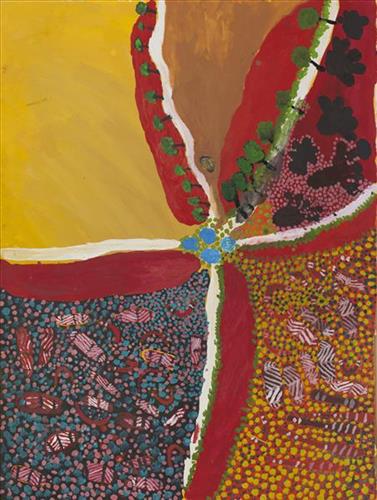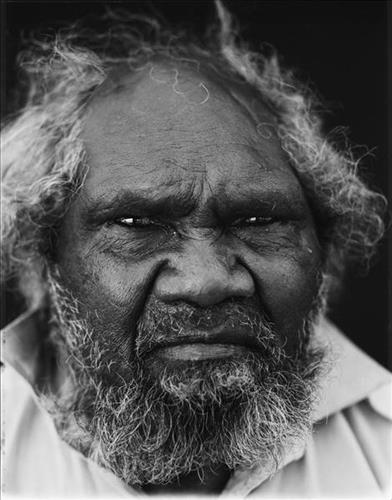111581406511
Kumpupirntily (Kumpupintily, Lake Disappointment)
“Ngayurnangalku [were] fighting, coming in from everywhere. They all come in here [at Kumpupirntily], all meet up here. Ngayurnangalku travelled through this Country going to Kumpupirntily. They made that Country. That Country got everything- parngarra (goanna), karlaya (emu), dog, kangaroo, all there. And Ngayurnangalku… they’re there too.
[Now the] Ngayurnangalku cannibal [live] in a lake, Kumpupirntily. They live in the lake, in the salt lake, that mob. They belong to there. They been born there, they living there, sleeping there. Big mob! That’s his [their] Country, Kumpupirntily. This one the Ngayurnangalku camp, they all there. They got their own city underground. Nobody ever know. Just like a store, you can lock him up. They got a big room, have a rest. Underground, not far. All the man, women, little kids, they all stopping there, and the mummy Ngayurnangalku, big mummy. All those little babies are his [hers]. There’s a hill there. They been walk all along here, they been get inside, that’s their hole over there. They all come and get in there. They got plenty jara (shield), yirrkili (boomerang), they property for the Ngayurnangalku, they maparn (holding power for sorcery). They hit you and kill you. He got to feed. Ngayurnangalku chuck away their jara and yirrkili when they go home. Pujurrpa (red ochre) there – that for Ngayurnangalku, make himself red, when he dance.
They chuck them [boomerangs] in the afternoon. Before the wind. If it’s a wind blowing, no good, they all go in, in that rock (hill). Parla-parla (type of lizard) is Ngayurnangalku mate. He’s for Kumpupirntily that one. That’s for Ngayurnangalku. When you see that lizard come out, like this (making a smacking sound with its mouth) you gotta get away, you gotta go long way. Don’t come desert. Don’t stop, Ngayurnangalku be get up. Parla-parla make him get up this mob, you gotta go away, run away.”
Ngayurnangalku still there [in Kumpupirntily]. They’re still alive. They walking in the night, they got to feed. They all staying there- don’t go there! You’ll lose your life. We’ll be dead, he’ll be alive. No people gotta go come to this place. If they go there it’s one way! There’s a cannibal there. Don’t come to this place- you might get killed! They gonna eat you for lunch! Don’t go, keep away! I been block him, tell all the miners to keep away. Cannibal gonna come out of the lake, kill you, knock you on the head and have a feed. If they dig him up, anybody, blackfella, whitefella, they’ll get killed! They’ll have a good feed!”
My grandfather went to Lake Disappointment chasing the dingo and he heard an old woman making a noise like howling, but she was crying for that dingo that my grandfather was spearing and chasing. So that woman grabbed his arm and put her long sharp fingernail through his wrist and paralysed him. She put her fingernail right through his wrist. Then that cannibal took him to a group of other cannibals, ready to cook him up to eat. They took him and had him there and they were singing him first. My grandfather is a strong maparn (magic) man. Lucky for him. He got out of there, because of his strength as a maparn.”
– Yunkurra Billy Atkins
Yunkurra’s Country encompasses one of the most important and dangerous sites in the Western Desert; Kumpupirntily (Kumpupintily, Lake Disappointment), home to the Ngayurnangalku (cannibal beings). Kumpupirntily, the Ngayurnangalku, and their associated Jukurrpa (Dreaming) form the subject for the majority of Yunkurra’s copious body of work.
Kumpupirntily is a stark, flat and unforgiving expanse of blinding salt lake surrounded by sand hills, located in the Little Sandy and Gibson Desert of Western Australia; “that Country hasn’t got any trees, it’s just open and flat” (Yunkurra Billy Atkins). Kumpupirntily translates to ‘bladder burst’; the lake was formed when the bladder of the Jila Kujarra (Two Snakes) burst here. Jila Kujarra is one of the key Jukurrpa narratives for the Martu. Though the story belongs to Warnman people, it is shared across the Western Desert with several other language groups. The narrative centres on the travels of two snakes as they are pursued by the Niminjarra, spiritual ancestors of the Warnman people.
Later in the Jukurrpa period the Ngayurnangalku (ancestral cannibal beings) made Kumpupirntily their home, where they continue to remain today. For this reason Kumpupirntily is considered one of the most sacred and dangerous sites of the Western Desert. The Ngayurnangalku are fearsome ancestral cannibal beings said to resemble people in their appearance, except for their fangs and long curved knife like fingernails they use to catch and hold their human victims. Coming from Natawalu (Canning Stock Route Well 40) in the north, Mundiwinti (Mundawindi) in the west, and from the Country around Kiwirrkurra in the east, the Ngayurnangalku travelled across the desert, stopping near Puntawarri, at Jilukurru (Killagurra Springs, Canning Stock Route Well 17) and at Kupayura (Savory Creek) before finally reaching Kumpupirntily.
At Kumpupirntily, the Ngayurnangalku had a meeting to debate whether or not they would continue to live as cannibals, and eventually came to the decision to stop eating people. That night, a female baby cannibal was born. Following protocol, the baby also had to be consulted by the group. She determined that the Ngayurnangalku should continue to eat people. Her decision divided the group, and from this point the group from the east continued to live as ‘bad’ cannibals at Kumpupirntily, while the group from the west became ‘good’, thereafter consuming only animals. The ‘good’ Ngayurnangalku are kept safe by Nganyangu men, ‘bodyguards’ who formed a sandhill in the middle of the lake. The Nganyangu also help to protect people from the cannibal Ngayurnangalku, providing a safe path of passage through Kumpupirntily.
The cannibal Ngayurnangalku continue to live beneath the crust of Kumpupirntily lake in an underground world lit by their own sun. They surface only to feed on human flesh, coming in and out of the world we see through a small hill that acts as a gateway between worlds; Yapu Maparnpa (magical hill). Stored with the Ngayurnangalku in their underground world is an arsenal of maparnpa (holding power for sorcery) weapons. Along with these weapons are deposits of pujurrpa that the Ngayurnangalku use to paint themselves with when they dance.
Several phenomena at Kumpupirntily act as a warning of the imminent appearance of the Ngayurnangalku; still skies, wilany (boomerang-shaped clouds), and the emergence of the parla-parla (type of lizard), smacking their mouths. The vigilance of the Martu as they travel in the Country around Kumpupirntily is so great that several other precautions are followed; fires are not lit, planes and helicopters are not flown directly over the area, and digging in the lake is strongly discouraged. All of these activities are believed to disturb the Ngayurnangalku, causing them to rise from their underground world.




